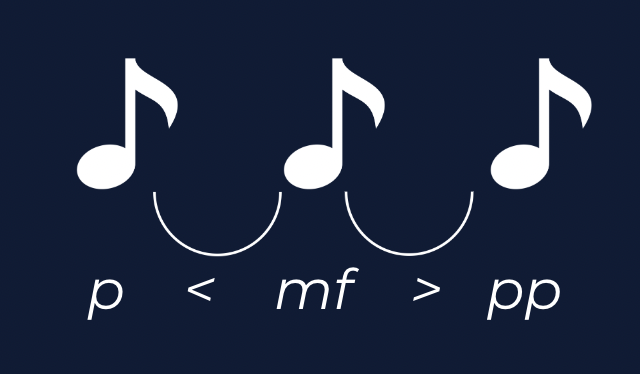
Who doesn’t know that situation: You are supposed to make a decision, but are simply overwhelmed. And instead of actually making a decision, you ruminate and think it through, over and over again.
Robert Fritz has a magnificent framework for making you aware of what you want and value. And once you know that, making the decision is obvious and straight forward.
Introduction to digital thinking
Robert Fritz came up with the following observation, which he turned into an effective and efficient decision making framework.
2 digital elements
He observed, there is either sound or there is not:

Which is similar to the computer world, where the switch is either on or not:

3 digital elements
From there the (musical) progression is either getting louder, staying the same or getting softer.

Digital Analysis
Let’s take that understand one step further and apply it to different situations to analyse possible scenarios. For example:
Analysis in A relationship:
- 2 digital elements:
- You can stay together (+)
- or not (-)
- 3 digital elements: In case you stay together, the relationship
- can improve (+)
- stay the same (0)
- get worse (-)
Analysis in an organisation
Let’s look at how digital analysis can be applied to organisations.
2-box: Performance analysis
Performance is often a function of how you design, and how you execute on that design. That makes 4 possible scenarios:
| Design | + | + | – | – |
| Execution | + | – | + | – |
- + / +: In an ideal world that happened
- + / -: Design is adequate but execution not
- – / +: Team works hard despite design not being optimal.
- – / -: Team and design are inadequate.
Other 2-Box examples can be:
- Price / Quality
- Size / Function
This analysis helps you to see where you currently are at.
Performance Review
The same framework can be used to evaluate the performance e.g. of an employee.
The steps that set you up:
- Chose an actual person in an actual job.
- Collect all the factors the supervisor will use to evaluate the employee performance.
- Assign a 2 or 3 for each factor as it is defined (no analysis yet).
- For all the factors ask:
- “Adequate (+) or inadequate (-)?”
- “Getting better (+), staying the same (0) or getting worse (-)?”
- Don’t get a story. Stay digital, not analog.
That can look as follows:
After assigning the evaluations it becomes obvious, where the focus needs to be and where the supervisor needs to pay attention and might support the employee. Performance is either adequate or not. (Performance ranking or standards with several points does not provide that clarity). If factors are inadequate that opens the door to explore why that is the case. This evaluation brings the focus back from the story, and puts employee and supervisor into reality. To support the employee in being successful and meeting the expectations at the same time. It gives you information about present and future. E.g. “inadequate and improving”: there is a place to go; “inadequate and worsening”: there is no place to go. This framework can be used so teams or employees could assess themselves, before being assessed by their supervisor.
3-Box: Analysis
You can modify the 2-box analysis to know everything about possible relationships between 2 elements and analyze where you are and what you need to focus on. For example the relationship between Total Market and your Market Share:
| Total Market | + | + | + | 0 | 0 | 0 | – | – | – |
| Market Share | + | 0 | – | + | 0 | – | + | 0 | – |
Details to 4 of the 9 scenarios:
- – / +: Pretty good outcome.
- 0 / -: Losing out to your competition.
- 0 / +: Gaining market share from someone.
- 1 / 0: Growing with the market
Organisational digital Dashboard
We can extend on the 2-box and 3-box analysis and use what we established to create an organisational dashboard with the elements that express the organisations effectiveness in achieving what they want. To see immediately the status quo and where focus and attention might be required.
For-Profit Organisations:

Non-Profit Organisations:

Elements are non definitive and can be tweaked.
Digital Decision Making
Now we come to the digital decision making process. The steps are as follows.
- Define the decision as +/- (Yes / No): What is the decision?
- You must define what decision it is that you want to make. It must be binary, meaning a ‘Yes’ or ‘No’ decision. For example: Should I do this or not.
- Collect the factors that the client is using to make the decision: What are the elements (no story) you consider to make this decision?
- Assign a 2 or 3 for each factor as it is defined.
- Test if there is a real decision to make:
- All one way: If it were all adequate, what would you do?
- All the other way: If it were all inadequate, what would you do?
- If yes, or no, both times, you are done the decision is made.
- If they are different, there is a decision to make.
- Clarifying values: Study various combinations of the factors, to study values.
- If it were this and that, what would you do?
- If it were that and this, what would you do?
- Important: You never question or correct the clients values.
- Reality check: Once you know the relationship among the factors, find out what is true in reality.
- In reality where do you stand?
- Announce the decision.
- If client doesn’t agree you may have missed an element and must add it in.
Illustration
Let’s take the decision to buy property A (or not) as an example:
| Elements | Debt | Have sth we want |
Global Uncertainty |
Future Flexibility |
Decision |
| All one way | + | + | + | + | Yes |
| All the other way | – | – | – | – | No |
| Clarifying values | – | + | Yes | ||
| Clarifying values | + | – | No | ||
| Clarifying values | + | + | Yes | ||
| Reality check | + | + | + | – | No |
Result: In that case, after clarifying the values and the hierarchy of the elements, the reality check reveals that the client is not buying the property.
Further context: Don’t let yourself be fooled of the simplicity of this process. It powerfully reveals your values. You make decision all the time, but are not necessarily aware of your values. Initially you really have to think about the elements, and going through the decision making process might bring up the need for more information and research. If you start with many elements, some might drop away as irrelevant.
Important: This is not about creating a ranking list of values, but understanding the structural relationships. The more you picture the clients elements, the more likely and sooner you become clear of the clients values and hierarchy.
Conclusion
In essence what I am describing here is very simple and straight forward. Though it might take some training to establish that understanding of simplicity.
That is what my offering and training curriculum Structural Creativity is really about:
To empower you to Be As You Are and Create What You Love! ❤️
And live in touch with reality
If that’s something that excites you and you wanna explore how I can support you – let’s connect!

